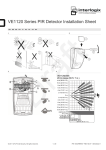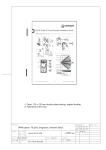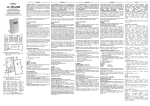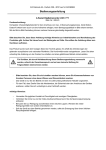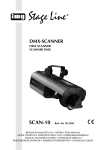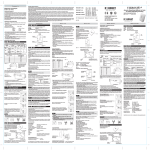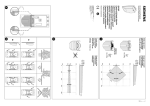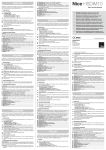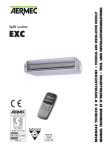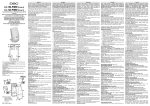Download EV1000 Series PIRs
Transcript
1. Form: 110x200 mm double sided printing, stapled booklet. 2. Fold to fit in box. 1 A 15-05-'07 2 A 2 8 - 11 - ' 0 7 White paper: 75 gr/m, progresso; overprint black. MANUAL EV1012, EV1012AM and EV1012AMZ Mikhail Sleptsov A4 146169999- 17-11-'08 GE Security 110-01 07-683 4 A 11 - 0 7 - ' 0 8 17152664 18499434 5 A 1 7 - 11 - ' 0 8 21555637 3 A 06-05-'08 EV1000 Series PIRs Installation Instructions EN FR NL DE IT ES PT PL SV Revision 4.3 (December 2008) • Part number 146169999-5A ! " Not pet immune (PI) # $ EV1012(AM)(Z) 12 m range (39' 4") For EN 50131 grade 3 installations, do not use mounting position C. % J1: Not used. J2: LED on. J3 and J4: LED off. See Figure '. J5: Terminal 8 = D/N. Terminal 8 = Remote test. J6: CV + polarity. CV - polarity. www.gesecurity.eu • Copyright © 2008 GE Security B.V. All rights reserved EV1000 Series PIRs Installation Instructions 2 & (7'10") (2'12") ' PIR/AM PIR PIR/AM EV1012AMZ EV1012 EV1012AM EV1012AM EV1012 = Control panel WT = Walk test AM = Anti-masking D/N = Day/Night Rtest = Remote test EV1000 Series PIRs Installation Instructions 3 EN Installation instructions Introduction The EV1000/1000AM family is made up of PIR/PIR-AM motion sensors. They have a patented mirror, pyro and signal processing technology. Installation guidelines The technology used in these detectors resists false alarm hazards. However, avoid potential causes of instability such as (see Fig. !): Direct sunlight on the detector. SW 3: Resetting the AM/TF output The system will only reset an AM alarm if it has ensured that the cause of the AM alarm has been removed. If the AM circuitry cannot return to its original reference levels, then either the detector is still masked or possibly has been damaged. The owner should then visually check that the detector is still fully functional. On: Resets the AM or TF status 40 seconds after a PIR alarm. Off: Resets the AM or TF status after a PIR alarm when the system is in Day and Walk Test status. The yellow LED will blink quickly. When the system is in Night status, the yellow LED will turn off and the system is reset (ex-factory). SW 4: Signaling AM or TF output Heat sources within the detector field of view. This DIP switch is not used with the AMZ version of detectors. Strong draughts onto the detector. Large animals within the detector field of view. Objects within 50 cm (20 in.) of the anti-masking (AM) detector. Obscuring the detector field of view with large objects, such as furniture. Installing two detectors facing each other and less than 50 cm (20 in.) apart. Installing the detector 1. Lift off the custom insert and remove the screw (see Fig. ", step 1). 2. Using a screwdriver, carefully prise open the detector (see Fig. ", steps 2 and 3). 3. Fix the base to the wall between 1.8 m and 3.0 m (5.9 and 9.8 ft.) from the floor. For flat mounting use a minimum of two screws (DIN 7998) in positions A. For corner-mounting use screws in positions B or C (Fig. #). To install a pry-off tamper, use position A or B. On: Signals AM on both the AM and Alarm relays. Signals TF on the AM relay only (EN 50131). Off: Signals AM and TF on the AM relay (ex-factory) SW 5: Setting LEDs On: Enables both LEDs on the detector at all times (ex-factory). Off: Puts both LEDs under the control of the Walk Test and Day/Night input. This activates the memory feature of the detector. LED indication Continuously on Normal blinking (1 Hz) Fast blinking (4 Hz) PIR Red LED Yellow Alarm AM relay LED relay To reset Start up Closed Automatically after 25 s Low voltage Open (Alarm) Apply correct voltage Open (Alarm) Automatically after 3s 4. Wire the detector (see Figs. # and '). 5. Select the desired jumper and DIP switch settings (see Fig. %). See section Setting the detector for more information. PIR intruder alarm 6. Remove the blinders and add the stickers, if required (see Fig. & for an example) PIR/AM 7. For ceiling-mount applications that require a 90° coverage use the SB01 swivel-mount bracket. Start up Closed Closed Automatically after 60 s 8. Close the cover. Low voltage Apply correct voltage 9. Insert the screw and place the custom insert. Open Open (Alarm) (Alarm) PIR intruder alarm Open (Alarm) Automatically after 3s 10. For EN 50131 grade 3 installations, do not use mounting position C. Setting the detector Red LED See figure % for the jumper locations in the detector. J1: Not used Switch toNight mode Open* Open (Alarm) (Alarm) On: Enables the detector LED at all times (ex-factory). Off: Puts the LED under control of the control panel and disables the detector LED at all times (no memory feature). J3 and J4: Dual loop setting Switch to Night mode J5: D/N mode (Day/Night) or Rtest (remote test) setting Do a successful walk test Technical specifications EV1012 EV1012AMZ PIR DSP Range 12 m Optical Memory J6: Polarity setting of the control voltage (CV) On: “Active High” provides the standard GE Security logic with “Active High” logic to enable Walk Test (WT) and Day/Night inputs. Off: “Active Low” provides “Active Low” logic to enable Walk Test and Day/Night inputs. Input power EV1012AM PIR + AM Signal processing Use this jumper to set terminal 8 to either D/N or Rtest. GE Security recommends that you use D/N to manage the AM/TF activation when required. Use Rtest to test the detector from the control panel. The detector will activate the Alarm relay if the test result is positive, and the AM relay if the test result is negative. Terminal 8 = Remote test Terminal 8 = D/N Ex-factory Active Low Open (Alarm) * Depends on the setting of the DIP switch SW4. Detector This sets the alarm and tamper relays. It allows you to connect the detector to any control panel. Use jumpers 3 and 4. See figure '. See DIP switch 3 After AM reset Technical fault J2: PIR enabling the LED To reset Latched PIR (Memory) AM alarm Jumper settings Active High Ex-factory Yellow Alarm AM relay LED relay 9 high-density mirror curtains No Yes 9 VDC to15 VDC (12 V nominal) Peak-to-peak ripple 2 V (at 12 VDC) Detector start-up time 25 s Normal current consumption (mA) 4.4 3.8 10 Current consumption in Alarm (mA) 1.2 3.9 3.8 Max. current consumption (mA) 11 24 24 Mounting height Target speed range 60 s Min. 1.8 m, max. 3.0 m (Min. 5.90 ft., max. 9.84 ft.) 30 cm/s to 3 m/s (1 ft./s to 10 ft./s) 20 cm/s to 3 m/s (8 in./s to 10 ft./s) Alarm (NC) / Tamper relay characteristic 80 mA 30 VDC SW 1: When to signal AM (anti-masking) or TF (technical fault) output Pry-off tamper Optional On-board (Yes) — 80 mA at 30 VDC max. On: Signals AM or TF only when the system is in Day mode (exfactory). Alarm time Off: Always signals AM or TF during Day and Night mode. Dimensions (H x W x D) DIP switch setting SW 2: AM sensitivity On: Selects a higher level of AM sensitivity. AM relay reacts within 6 seconds. Off: Selects the standard AM sensitivity. AM relay reacts within 12 seconds (ex-factory). AM relay characteristic Operating temperature IP/IK rating 80 mA 30 VDC 3s -10°C to +55°C (14°F to 130°F) 108 × 60 × 46mm (4.25 × 2.36 × 1.81 in.) Relative humidity Weight non Max. 95% 120 g (4.2 oz.) 128 g (4.5 oz.) IP30 IK02 EV1000 Series PIRs Installation Instructions 4 Manuel d’installation FR Introduction et compatibilité Réglage commutateur DIP SW 1 : Quand signaler les sorties AM (anti-masque) ou PT (problème technique) Signale les alarmes AM ou PT uniquement quand le système est en mode jour (sortie d’usine). La gamme EV1000 / 1000AM est constituée de détecteurs de mouvements IRP/IRP-AM. Ceux-ci possèdent une technologie brevetée de miroir, capteur pyro et traitement du signal. Le détecteur EV1012AMZ est uniquement utilisable avec les centrales de la Gamme ATS équipées d’une version de firmware égale ou supérieure à 04-09-XX (ATS2102/2402/3402/4602) et version 0410-04 pour l’ATS1002. Activé : Instructions d'installation Désactivé : Sélectionne la sensibilité d’anti-masque standard. Le relais AM réagit en moins de 12 secondes (sortie d’usine). La technologie utilisée dans ces détecteurs est conçue pour résister aux risques de fausses alarmes. Toutefois, il est conseillé d’éviter les causes d'instabilité potentielles, telles que (voir fig. !) : L’exposition du détecteur à la lumière directe du soleil. Les sources de chaleur dans le champ de vision du détecteur. Les courants d’air puissants sur le détecteur. La présence de grands animaux dans le champ de vision du détecteur. La présence d’objets à moins de 50 cm du détecteur antimasque (AM). L’obstruction du champ de vision du détecteur par des objets volumineux, comme des meubles. L’installation de deux détecteurs face à face à moins de 50 cm de distance. Installation du détecteur 1. Soulevez le couvercle et retirez la vis (voir fig. ", étape 1). 2. A l’aide d’un tournevis, ouvrez délicatement le détecteur en faisant levier (voir fig. ", étapes 2 et 3). 3. Fixez la base au mur à une hauteur comprise entre 1,8 m et 3 m du sol. Pour un montage à plat utiliser au minimum deux vis (DIN 7998) en position A. Pour le montage en coin, utilisez les vis en positions B ou C (fig. #). Utiliser la position A ou B pour installer l'autoprotection, pour les modèles avec anti masque. 4. 5. Raccordez le détecteur (voir figures # et ') en utilisant un câble de 3 à 5 paires, en fonction du type de raccordement, avec ou sans écran et constitué de conducteurs, souples ou rigides, d’un diamètre de 0.8mm. Sélectionnez le cavalier requis et la configuration des commutateurs DIP (voir fig. %). Pour plus d’informations, consultez la section Réglage du détecteur. Désactivé : Signale toujours l’AM ou le PT en mode Jour et Nuit. SW 2 : Sensibilité d’anti-masque Activé : Augmente la sensibilité d’anti-masque. Le relais AM réagit en moins de 6 secondes. SW 3 : Réinitialisation des sorties AM/PT Le système réinitialise une alarme AM une fois qu’il est sûr que la cause de l’alarme AM a été supprimée. Si le circuit AM ne peut pas revenir à ses niveaux de référence d’origine, soit le détecteur est toujours masqué, soit il a été endommagé. Le propriétaire doit alors vérifier physiquement si le détecteur est toujours fonctionnel. Activé : Réinitialise l’état AM ou PT 40 secondes après une alarme IRP. Désactivé : Réinitialise l’état AM ou PT suite au déclenchement d’une alarme IRP, lorsque le système est en mode jour et test de marche. Le témoin jaune clignote rapidement. Lorsque le système est en état nuit, le témoin jaune s’éteint et le système se réinitialise (sortie d’usine). SW 4 : Signalisation des sorties AM ou PT Ce commutateur DIP n’est pas utilisé avec la version AMZ des détecteurs. Activé : Signale les sorties AM à la fois sur les relais AM et d’alarme. Signale les sorties PT sur le relais AM uniquement (EN 50131). Désactivé : Signale les sorties AM et PT sur le relais AM (sortie d’usine). SW 5 : Réglage des témoins lumineux Activé : Active en permanence les deux témoins lumineux du détecteur (sortie d’usine). Désactivé : Met les deux témoins sous contrôle des entrées test de marche et jour/nuit. Ceci active la fonction de mémoire du détecteur. Explication des témoins 6. Retirez les masques et ajoutez les autocollants si nécessaire (voir fig. & pour exemple). 7. Pour les applications de montage au plafond requérant une couverture de 90 °, utilisez la patte de fixation à pivot SB01. IRP 8. Fermez le panneau de couverture. Démarrage Fermé 9. Insérez la vis et remettez le couvercle en place. Automatiquement après 25 s Basse tension Ouvert (alarme) Utiliser une tension correcte Alarme intrusion IRP Ouvert (alarme) Automatiquement après 3 s 10. Pour les installations EN 50131 grade 3, ne pas utiliser le montage en position C. Réglage du détecteur Réglage du cavalier Allumé en continu Clignotement rapide (4 Hz) Témoin Témoin Relais Relais rouge jaune d'alarme AM IRP/AM Reportez-vous à la figure % pour connaître les emplacements du cavalier dans le détecteur. J1 : Non utilisé J2 : Activation du témoin lumineux avec l'IRP Témoin Témoin Relais Relais rouge jaune d'alarme AM Fermé Basse tension Ouvert (alarme) Ouvert Utiliser une tension (alarme) correcte Ouvert (alarme) Alarme intrusion IRP Off (Désactivé) : Met le témoin lumineux sous le contrôle de la centrale et désactive le témoin lumineux du détecteur (pas de fonction de mémoire). IRP verrouillé (mémoire) Alarme AM J6 : Réglage de la polarité de tension de contrôle (TC) Activé : « Sortie active » fournit la logique GE Security standard avec une sortie active pour activer les entrées test de marche et jour/nuit. Désactivé : « Sortie non active » fournit une sortie non active pour activer les entrées test de marche et jour/nuit. Logique active haute Sortie d’usine Actif Bas Automatiquement après 60 s Automatiquement après 3 s Passer au mode nuit Ouvert* (alarme) Ouvert Voir commutateur (alarme) DIP 3 Passer en mode nuit Après réinitialisation de l’AM Ouvert Réussir un test de (alarme) marche Problème technique J5 : Paramètre du mode J/N (Jour/Nuit) ou du test à distance Utilisez ce cavalier pour régler le terminal 8 sur J/N ou test à distance. GE Security recommande l’utilisation de J/N pour gérer l’activation d’AM/PT quand cela est nécessaire. Utilisez le test à distance pour tester le détecteur à partir de la centrale. Le détecteur active le relais d’alarme si le résultat du test est positif et le relais AM si le résultat du test est négatif. Terminal 8 = Test à distance Terminal 8 = J/N Sortie d’usine Réinitialisation Fermé Active le témoin lumineux du détecteur à tout moment (sortie d’usine). J3 et J4 : Configuration de la boucle double Réinitialisation Démarrage On Activé) : La boucle double permet de régler les relais d’alarme et d’autoprotection. Elle permet de connecter le détecteur à tout type de centrale. Elle utilise les cavaliers 3 et 4. Voir fig. '. Clignotement normal (1 Hz) * Dépend du paramétrage du commutateur DIP SW4. Spécifications techniques EV1012 Statut Traitement du signal Mémoire EV1012AM IRP + AM DSP Catégorie Optique EV1012AMZ IRP 12 m 9 miroirs à rideau haute densité Non Tension d’alimentation Oui 9 à 15 V CC (12 V nominal) Ondulation crête à crête 2 V (à 12 V CC) Temps de démarrage du détecteur 25 s 60 s Consommation au repos, hors alarme (mA) 4.4 3.8 10 Consommation en alarme, sans activation Led (mA) 1.2 3.9 3.8 EV1000 Series PIRs Installation Instructions 5 EV1012 Consommation en alarme avec Led activée (mA) EV1012AMZ 11 Hauteur de montage EV1012AM 24 24 Min. 1,8 m, max. 3,0 m Vitesse cible De 30 cm/s à 3 m/s Caractéristiques du relais d’alarme (NC) / d’autoprotection Protection contre l’arrachement 80 mA, 30 V CC De 20 cm/s à 3 m/s J5: Instelling van D/N-modus (Dag/Nacht) of Rtest (test op afstand) non Met deze jumper kunt u aansluiting 8 op D/N of Rtest instellen. GE Security raadt aan dat u D/N gebruikt voor het controleren van de AM/TF-activering, indien nodig. Gebruik Rtest om de detector te testen vanaf de centrale. De detector activeert het alarmrelais als het testresultaat positief is en activeert het AM-relais als het testresultaat negatief is. Terminal 8 = Terminal 8 = D/N Test op afstand (fabrieksinstelling) 80 mA, 30 V CC Optionnelle Oui, d’origine — 80 mA à 30 V cc max. Caractéristiques du relais AM Temps d’alarme 3s Température de fonctionnement de -10 °C à +55 °C Dimensions (H x L x P) 108 × 60 × 46 mm Humidité relative J6: Polariteitsinstelling van de regelspanning (CV) Aan: “Actieve hoge” biedt de standaard GE Security-logica met “Actieve hoge”-logica om de ingangen Looptest (WT) en Dag/Nacht (D/N) in te schakelen. 95 % max. Poids 120 g 128 g Classe IP/IK IP30 IK02 Angle de détetion NFA2P 79° à 8m Portée max NFA2P J3 en J4: Dubbele lusinstelling Hiermee stelt u de alarm- en sabotagerelais in. U kunt de detector hiermee op elk controlepaneel aansluiten. Gebruik de jumpers 3 en 4. Zie fig.'. Uit: “Actieve lage” biedt “Actieve lage”-logica om de ingangen Looptest en Dag/Nacht in te schakelen. Actieve hoge (fabrieksinstelling) 12m EV1012 : NFA2P grade 2 n° xxxxxx-xx EV1012AM : NFA2P grade 3 n° xxxxxx-xx EV1012AMZ : NFA2P grade 3 n° xxxxxx-xx CNPP B.P. 2265 27950 St Marcel Tel : 02 32 53 64 22 Instelling DIP-switch SW 1: Wanneer u AM (anti-maskering) of TF (technische fout) moet melden AFNOR 11 rue Pressensé 93571 La Plaine St Denis Tel : 01 46 11 37 00 Aan: AM of TF alleen melden wanneer het systeem in de modus Dag staat uitgeschakeld (fabrieksinstelling). Uit: Geeft altijd het signaal AM of TF tijdens Dag- en Nacht-modus. SW 2: AM-gevoeligheid Aan: NL Installatie-instructies Een hoge AM-gevoeligheid selecteren. AM-relais reageert binnen 6 seconden. De standaard AM-gevoeligheid selecteren. AM-relais reageert binnen 12 seconden (fabrieksinstelling). SW 3: De AM/TF-uitgang resetten Het systeem zal alleen een AM-alarm resetten als is geconstateerd dat de oorzaak van het AM-alarm is verwijderd. Als het AM-niveau niet kan terugkeren naar de oorspronkelijke referentieniveaus, dan is de detector nog steeds gemaskeerd of is mogelijk beschadigd. De eigenaar moet vervolgens visueel controleren of de detector nog steeds volledig functioneel is. Uit: Inleiding De EV1000 / 1000AM-serie bestaat uit PIR / PIR-AMbewegingssensors. Ze zijn voorzien van gepatenteerde spiegel-, pyro- en signaalverwerkingstechnologie. Richtlijnen voor de installatie De technologie in deze detectors maakt het systeem minder gevoelig voor valse alarmen. Vermijd echter bepaalde situaties die instabiliteit kunnen veroorzaken, zoals (zie fig. !): Rechtstreeks zonlicht op de detector. Warmtebronnen binnen het detectieveld van de detector. Aan: Stelt de AM- of TF-status 40 seconden na een PIR-alarm opnieuw in. Uit: De AM- of TF-status wordt gereset na een PIR-alarm, mits ingesteld op een Dag- en Loopteststatus. De gele lLED gaat snel knipperen. Als het systeem zich in de stand Nacht bevindt, gaat de gele LED uit en wordt het systeem gereset (fabrieksinstelling). Veel tocht op de detector. Grote dieren binnen het detectieveld van de detector. Objecten binnen 50 cm van de AM-detector (anti-maskering). Het kijkveld van de detector afschermen met grote objecten, zoals meubels. Twee detectors recht tegenover elkaar en met minder dan 50 cm tussenruimte installeren. SW 4: Signalering van AM- of TF-uitgang Deze DIP-schakelaar wordt niet gebruikt voor de AMZversie van detectors. Aan: Antimaskeringssignaal afgeven op zowel het AM-relais als het alarmrelais. Technische storing alleen melden op het AM-relais (EN 50131). Uit: AM en TF alleen melden op het AM-relais (fabrieksinstelling). De detector installeren 11. Til het afdekplaatje omhoog en verwijder de schroef (zie fig. ", stap 1). 12. Maak de detector voorzichtig open schroevendraaier (zie fig. ", stappen 2 en 3). Actieve lage met een 13. Monteer de achter box tegen de muur tussen 1,8 m en 3,0 m vanaf de vloer. Gebruik voor vlakke montage minimaal twee schroeven (DIN 7998), in positie A. Gebruik voor hoekmontage schroeven in de positie B of C (fig. #). Bij installatie van de afneem sabotage beveiliging gebruik positie A of B. 14. Breng de bedrading van de detector aan (zie fig. # en '). 15. Selecteer de gewenste instellingen voor de jumper en DIPschakelaars (zie fig. %). Zie het gedeelte De detector instellen voor meer informatie. SW 5: LEDs instellen Aan: Beide leds op de detector blijven permanent ingeschakeld (fabrieksinstelling). Uit: Wanneer het systeem is uitgeschakeld, worden beide leds geregeld door de ingang Looptest en Dag/Nacht in te schakelen. Dit activeert de geheugenfunctie van de detector. LED-indicatie Continu aan Normaal knipperend (1 Hz) Snel knipperen (4 Hz) 16. Verwijder de spiegelsegment afschermingen kapjes maskers en breng de stickers aan, indien nodig (zie fig. &). PIR 17. Als u de detector aan het plafond wilt bevestigen voor een 90° dekking, moet u de SB01-beugel gebruiken. Opstarten Gesloten Automatisch na 25 sec 19. Breng de schroef weer aan en zet het afdekplaatje terug. Lage spanning Open (Alarm) Correcte spanning toepassen 20. Voor EN 50131 grade 3 installaties, maak geen gebruik van montagepositie C. PIRinbraakalarm Open (Alarm) Automatisch na 3 sec De detector instellen PIR/AM 18. Plaats het front terug. Jumperinstellingen Zie figuur % voor de locatie van de jumpers in de detector. J1: Niet in gebruik J2 : PIR voor inschakelen van de LED Aan: Schakelt de LED permanent aan (fabrieksinstelling). Uit: Plaatst de LED onder de controle van de centrale en schakelt de LED permanent uit (geen geheugenfunctie). Rode Gele Alarmrelais LED LED Rode Gele Alarmrelais LED LED AM-relais Opnieuw instellen AM-relais Opnieuw instellen gesloten Automatisch na 60 sec Opstarten gesloten Lage spanning Open (Alarm) Open (Alarm) Correcte spanning toepassen PIRinbraakalarm Open (Alarm) Automatisch na 3 sec Vergrendeld PIR (geheugen) Overschakelen naar Nacht-modus EV1000 Series PIRs Installation Instructions 6 PIR/AM Rode Gele Alarmrelais LED LED AM-alarm AM-relais Open* (Alarm) Open (Alarm) Na AM-reset Technische storing Open (Alarm) Opnieuw instellen 9. Zie DIPschakelaar 3 10. Bei EN50131 Grad 3 Installationen Montageposition C nicht verwendet werden. Overschakelen naar Nacht-modus Einstellen des Melders Een looptest goed uitvoeren * Is afhankelijk van de instelling van dip schakelaar SW4. EV1012 EV1012AMZ PIR EV1012AM PIR + AM DSP Bereik 12 m Optisch 9 spiegelgordijnen met hoge dichtheid Aansluitspanning Nee Opstarttijd detector 2 V (bij 12 VDC) 25 sec 4.4 3.8 10 Stroomverbruik in alarmtoestand (mA) 1.2 3.9 3.8 Maximaal stroomverbruik (mA) 11 24 24 Alarm (NC) / Sabotagerelais kenmerk Verwenden Sie diese Steckbrücke, um Anschlussklemme 8 entweder auf D/N oder Rtest einzustellen. GE Security empfiehlt für die erforderliche Verwaltung der AM/TF-Aktivierung die Einstellung D/N. Verwenden Sie Rtest, um den Melder von der Einbruchmeldezentrale aus zu testen. Der Melder aktiviert das Alarmrelais, wenn das Testergebnis positiv ist. Bei einem negativen Testergebnis wird das Abdeckungs (AM)-Relais aktiviert. Min. 1,8 m. en max. 3,0 m 30 cm/s tot 3 m/s Anschlussklemme 8 = D/N Werkseinstellung 20 cm/s tot 3 m/s 80 mA 30 VDC niet 80 mA 30 VDC Afneembeveiliging Optioneel Ingebouwd (Ja) AM-relais kenmerk — 80 mA bij 30 VDC max. Alarmtijd Omgevingstemperatuur 3 sec -10°C tot +55°C (14°F tot 130°F) Afmetingen (H x B x D) Gewicht Max. 95% 120 g Aktiv Low DIP-Schaltereinstellung 128 g IP/IK-klasse Anschlussklemme 8 = Ferntest J6: Polaritätseinstellung der Steuerspannung (CV) Ein: „Aktiv High“ stellt der standardmäßigen GE SecuritySteuerlogik die „Aktiv High“ Logik zur Verfügung, um die Eingänge für Gehtest (WT) und Scharf/Unscharf zu steuern. Aus: „Aktiv Low“ die stellt „Aktiv Low“ Logik zur Verfügung, um die Eingänge für Gehtest und Scharf/Unscharf zu ermöglichen. Aktiv High Werkseinstellung 108 × 60 × 46 mm Relatieve luchtvochtigheid Die LED wird von der Einbruchmeldezentrale gesteuert und die Melder-LED ist immer deaktiviert (keine Speicherfunktion). J5: Einstellung für D/N-Modus (Scharf/Unscharf) oder Rtest (Ferntest) 60 sec Normaal stroomverbruik (mA) Bewegingsnelheid J2: PIR aktiviert die LED Die Melder-LED ist immer aktiviert (Werkseinstellung). Ein: Dient zur Einstellung des Alarm- und Sabotagerelais. Sie können damit den Melder an eine beliebige Einbruchmeldezentrale anschließen. Verwenden Sie die Steckbrücken 3 und 4 (Abb. '). 9 VDC tot 15 VDC (12 V nominaal) Montagehoogte Siehe Abbildung % für die Steckbrückenpositionen (J1-6) im Melder. J3 und J4: Einstellung für Dual-Meldegruppe Ja Max rimpelspanning piektot-piek die Steckbrückeneinstellungen Aus: Signaalverwerking Geheugen darf J1: Nicht verwendet Technische specificaties Detector Setzen Sie die Schraube und die kundenspezifische Abdeckkappe wieder ein. SW 1: Wann eine Abdeckungs(AM)- oder Technischer Fehler(TF)-Ausgabe signalisiert werden sollte Ein: Signalisiert AM oder TF nur, wenn sich das System im Tagbetrieb (unscharf) befindet (Werkseinstellung). IP30 IK02 DE Installationsanweisungen Aus: Signalisiert AM oder TF immer im Scharf- und Unscharfbetrieb. Einführung SW 2: AM-Empfindlichkeit Die Serie EV1000-D/1000AM-D besteht aus PIR/PIR-AMBewegungsmeldern. Letztere verfügen über einen patentierten Spiegel sowie Pyro- und Signalverarbeitungstechnologie. Ein: Wählt eine höhere Stufe der Abdeckungsempfindlichkeit aus. AM-Relais reagiert innerhalb von 6 Sekunden. Installationsanleitungen Aus: Wählt die Standard-Abdeckungsempfindlichkeit aus. Große Tiere innerhalb des Erfassungsbereichs des Melders. AM-Relais reagiert innerhalb von 12 Sekunden (Werkseinstellung). SW 3: Zurücksetzen des AM/TF-Ausgangs Das System setzt einen AM-Alarm nur zurück, wenn er sicher ist, dass die Ursache des AM-Alarms behoben wurde. Wenn der AMSchaltkreis nicht zu seiner ursprünglichen Referenzebene zurückkehren kann, ist entweder der Melder noch abgedeckt oder wurde möglicherweise beschädigt. Der Betreiber sollte dann nachschauen, ob der Melder noch voll funktionsfähig ist. Objekte innerhalb von Abdeckerkennung (AM). mit Ein: Setzt den AM- oder TF-Status 40 Sekunden nach einem PIRAlarm zurück. Verdecken des Erfassungsbereichs des Melders durch große Objekte, z. B Möbel. Aus: Setzt den AM- oder TF-Status nach einem PIR-Alarm zurück, wenn das System in den Unscharf- und Gehtest-Modus geschaltet wurde. Die gelbe LED wird schnell blinken. Wenn sich das System im Scharfmodus befindet, erlischt die gelbe LED-Anzeige und das System wird zurückgesetzt (Werkseinstellung). Die in diesen Meldern eingesetzte Technologie dient zur Vermeidung falscher Alarmmeldungen. Dennoch sollten Sie potenzielle Instabilitätsfaktoren vermeiden (Abb. !), darunter: Direkte Sonneneinstrahlung auf den Melder. Hitzequellen innerhalb des Erfassungsbereichs. Starke auf den Melder gerichtete Zugluft. 50 cm des Melders Montage zweier gegenüberliegender Melder in einem Abstand von weniger als 50 cm. Installation des Melders 1. Nehmen Sie die kundenspezifische Abdeckkappe ab und entfernen Sie die Schraube (Abb. ", Schritt 1). 2. Öffnen Sie den Melder vorsichtig mit einem Schraubendreher (Abb. ", Schritte 2 und 3). 3. Befestigen Sie die Basis in einem Abstand von 1,80 m bis 3 m vom Boden an der Wand. Verwenden Sie bei der Wandmontage mindestens 2 Schrauben (DIN 7998) in den Positionen A. Verwenden Sie für eine Eckmontage Schrauben in den Positionen B oder C (Abb. #). Bei Installation eines Abreißkontakts, verwenden Sie die Positionen A oder B. 4. Verkabeln Sie den Melder (Abb. # und '). 5. Wählen Sie die gewünschten Steckbrücken- und DIPSchaltereinstellungen aus (Abb. %). Weitere Informationen finden Sie im Abschnitt Einstellen des Melders. 6. Entfernen Sie die Spiegel-Abdeckungen und bringen Sie bei Bedarf die Aufkleber an (Abb. & enthält ein Beispiel) 7. Verwenden Sie für Deckenmontagen, bei der eine Überwachung von 90° erforderlich ist, den Befestigungssatz für Wand- und Deckenmontagen (SB01). 8. Schließen Sie die Abdeckung. SW 4: Signalisiert AM- oder TF-Ausgang Dieser DIP-Schalter hat bei AMZ-Melderversionen keine Funktion. Ein: Signalisiert AM (Abdeckung) auf dem AM- und auf dem Alarmrelais. Signalisiert TF nur auf dem AM-Relais (EN 50131). Aus: Signalisiert AM und TF auf dem AM-Relais (Werkseinstellung). SW 5: Einstellen von LEDs Ein: Aktiviert ständig beide LEDs auf dem Melder (Werkseinstellung). Aus: Beide LEDs werden durch den Eingang für Gehtest und durch die Einstellung für Scharf/Unscharf gesteuert. Dies aktiviert die Speicherfunktion des Melders. EV1000 Series PIRs Installation Instructions 7 LED-Anzeige Installazione del rivelatore Ständig Ein Normales Blinken (1 Hz) Schnell blinkend (4 Hz) PIR Rote LED Gelbe LED Alarmrelais AMRelais Geschlossen Automatisch nach 25 Sek. Unterspannung Offen (Alarm) Verwenden Sie die korrekte Spannung PIREinbruchalarm Offen (Alarm) Automatisch nach 3 Sek. Rote LED Gelbe LED Alarmrelais AMRelais Zurücksetzen Start Geschlossen Geschlossen Automatisch nach 60 Sek. Unterspannung Offen (Alarm) Offen (Alarm) Verwenden Sie die korrekte Spannung PIREinbruchalarm Offen (Alarm) Automatisch nach 3 Sek. PIR-Speicher Schalten Sie 1 x Scharf/Unscharf AM-Alarm Offen* (Alarm) Offen (Alarm) Siehe DIP-Schalter 3 Schalten Sie 1 x Scharf/Unscharf Nach Zurücksetzen von AM Technischer Fehler Offen (Alarm) Führen Sie einen erfolgreichen Gehtest durch * Abhängig von der Einstellung von DIP-Schalter SW4. Technische Daten EV1012-D Melder EV1012AMZ PIR EV1012AM PIR + AM Signalauswertung DSP Reichweite 12 m Optik 9 Spiegelvorhänge mit hoher Dichte Speicher Nein Versorgungsspannung Meldereinschaltzeit Ja 9 bis 15 V Gleichspannung (12 V nominal) Spitze/SpitzeBrummspannung 2 V (bei 12 V Gleichspannung) 25 Sek. Normale Stromaufnahme (mA) 4,4 3,8 10 Stromaufnahme bei Alarm (mA) 1,2 3,9 3,8 Maximale Stromaufnahme (mA) 11 24 24 Min. 1.8 m, max. 3.0 m Erfassungsgeschwindigkeitsbereich Notschalter für Gehäuseöffnung Optional Intern (Ja) — 80 mA bei 30 V Gleichspannung max. Betriebstemperatur keine 80 mA 30 VDC 3 Sek. -10 °C bis +55 °C (14 °F bis 130 °F) Abmessungen (H x B x T) 108 × 60 × 46 mm Relative Luftfeuchtigkeit Max. 95 % Gewicht IP/IK-Einstufung 3. Fissare la base al muro ad un'altezza dal pavimento compresa tra 1,8 e 3 m. Per il fissaggio a parete utilizzare almeno due viti (DIN7998) nelle posizioni A. Per il montaggio angolare, utilizzare le viti nelle posizioni B o C (fig. #). Per installare un contatto antirimozione, utilizzare la posizione A o B. 4. Collegare il rivelatore (fig. # e '). 5. Selezionare le impostazioni desiderate dei ponticelli e dei commutatori DIP switch (vedere fig. %). Per ulteriori informazioni, vedere la sezione Impostazione del rivelatore. 6. Rimuovere la schermatura e applicare gli adesivi secondo necessità (per un esempio vedere la fig. &). 7. Per applicazioni con montaggio a soffitto che richiedano una copertura a 90°, utilizzare il supporto mobile SB01. 8. Chiudere il coperchio. 9. Inserire la vite e riposizionare al suo posto la chiusura a incastro. 120 g 10. Per installazioni l'EN 50131 grado 3, non utilizzare la posizione C. Dispositivo antirimozione EV1012 Su questi modelli il dispositivo antirimozione è opzionale. Inserire il dispositivo ST400 quando viene richiesta la protezione antirimozione (per la conformità alle norme CEI 79.2 è obbligatorio l’utilizzo del kit antirimozione ST400). EV1012AM, EV1012AMZ Su questi modelli il dispositivo antirimozione è integrato nel circuito stampato del rivelatore. Viene attivato con l’apposito pin riportato in figura # sopra la morsettiera del rivelatore. Per utilizzare il sistema antirimozione, si deve fissare il rivelatore alla parete tramite uno dei fori di montaggio indicati con A e B posti sopra la morsettiera del rivelatore (vedi figura #). Il sistema antirimozione può essere utilizzato in posizione di montaggio su parete piana e in una sola posizione di montaggio ad angolo (Figura #, B). Impostazione del rivelatore Impostazioni dei ponticelli Per le posizioni dei ponticelli nel rivelatore, vedere la figura %. J1: non utilizzato Chiuso: 80 mA 30 VDC Alarmdauer Aprire il rivelatore facendo leva con un cacciavite (fig. ", punti 2 e 3). J2: PIR che attiva il LED 20 cm/Sek. bis 3 m/Sek. Eigenschaften Alarm- (NC) / Sabotagerelais Eigenschaften AM-Relais 2. Per la conformità alle norme CEI 79.2 è obbligatorio l’utilizzo della protezione antirimozione. 60 Sek. Montagehöhe Sollevare la chiusura a incastro e rimuovere la vite (vedere fig. ", punto 1). Zurücksetzen Start PIR/AM 1. 128 g IP30 IK02 IT Istruzioni per l'installazione Introduzione La famiglia EV1000 / 1000AM è costituita da rivelatori di movimento PIR/PIR-AM. Sono dotati di uno specchio brevettato, sensore pirolettrico ed elaborazione del segnale. Linee guida per l'installazione La tecnologia utilizzata per questi rivelatori è a prova di falsi allarmi. È tuttavia necessario evitare potenziali cause di instabilità, quali (vedere la fig. !): Esposizione del rivelatore alla luce solare diretta. Fonti di calore nel campo visivo del rivelatore. Forti correnti d'aria in prossimità del rivelatore. Animali di grosse dimensioni nel campo visivo del rivelatore. Presenza di oggetti nel raggio di 50 cm dal rivelatore antimascheramento (AM). Oscuramento del campo visivo del rivelatore con oggetti di grandi dimensioni (es. mobilio). Installazione di due rivelatori l'uno di fronte all'altro a meno di 50 cm di distanza. Aperto: attiva il LED del rivelatore (impostazione di fabbrica). mette il LED sotto il controllo della centrale (nessuna funzione memoria). J3 e J4: impostazione circuito doppio bilanciamento Imposta i relè di allarme e antimanomissione e consente di collegare il rivelatore a qualsiasi centrale. Utilizzare i ponticelli 3 e 4. Vedere fig. '. J5: impostazione del modo D/N (giorno/notte) o Rtest (test remoto) Utilizzare questo ponticello per impostare il terminale 8 su D/N o Rtest. GE Security consiglia di utilizzare D/N per gestire l'attivazione AM/TF quando necessario. Utilizzare Rtest per testare il rivelatore dalla centrale. Il rivelatore attiva il relè allarme se il risultato del test è positivo e il relè antimascheramento se il risultato del test è negativo. Terminale 8 = Terminale 8 = D/N Test remoto impostazione di fabbrica J6: impostazione della polarità della tensione di controllo (CV) Chiuso: "Attiva alta" fornisce la logica standard GE Security attiva alta che abilita gli ingressi test di copertura (WT) e giorno/notte (D/N). Aperto: "Attiva bassa" fornisce la logica attiva bassa che abilita gli ingressi test di copertura e giorno/notte. Attiva alta Impostazione di fabbrica Attiva bassa Impostazione commutatore DIP-switch SW 1: quando segnalare l'uscita AM (antimascheramento) o TF (guasto tecnico) On: segnala l'uscita AM o TF solo quando il sistema è nel modo giorno (impostazione di fabbrica). Off: segnala sempre AM o TF durante il modo giorno e notte. SW 2: sensibilità AM On: seleziona un elevato livello di sensibilità antimascheramento. Il relè antimascheramento reagisce entro 6 secondi. EV1000 Series PIRs Installation Instructions 8 Off: seleziona la sensibilità antimascheramento standard. Il relè antimascheramento reagisce entro 12 secondi (impostazione di fabbrica). SW 3: reset dell'uscita AM/TF Il sistema consente il reset di un allarme antimascheramento solo dopo aver accertato che la causa dell'allarme è stata rimossa. Se i circuiti antimascheramento non possono tornare ai livelli di riferimento iniziali, significa che il rivelatore è ancora mascherato o è possibile che sia stato danneggiato. L'utente deve accertarsi tramite ispezione visiva della corretta funzionalità del rivelatore. On: resetta lo stato AM o TF da 40 secondi dopo l’attivazione, mediante un allarme PIR . Off: resetta lo stato AM o TF mediante un allarme PIR, quando il sistema è impostato nello stato giorno e l’ingresso test di copertura (walk test) è attivato. Il LED giallo lampeggerà velocemente. Quando il sistema è nello stato notte, il LED giallo si spegne e il sistema si resetta (impostazione di fabbrica). EV1012 Tempo di allarme On: segnala AM su entrambi i relè AM e allarme e TF solo sul relè AM (EN 50131). Off: segnala AM e TF solo sul relè AM (impostazione di fabbrica). SW 5: impostazione dei LED On: attiva entrambi i LED del rivelatore in qualsiasi momento (impostazione di fabbrica). Off: mette entrambi i LED sotto il controllo degli ingressi test di copertura (walk test) e giorno/notte (day/night). Ciò attiva la funzione di memoria del rivelatore. Dimensioni (A x L x P) Approvals Regno Unito Omologato IMQ II° Livello (per la conformità alle norme CEI 79-2 è necesssario l'utilizzodel kit antirimozione ST400). EV1012, EV1012AM, EV1012AMZ Introducción La gama EV1000/1000AM está fabricada con sensores de movimiento PIR/PIR-AM. Cuentan con tecnología patentada de espejos, sensores piroeléctricos y procesamiento de la señal. Instrucciones para la instalación La tecnología utilizada en estos detectores resiste riesgos de falsas alarmas. Sin embargo, debe evitar posibles causas de inestabilidad, como por ejemplo (consulte la figura !): Luz solar directa en el detector. Fuentes de calor dentro del campo de visión del detector. Fuertes corrientes de aire sobre el detector. Oscurecer el campo de visión del detector con objetos de gran tamaño, como por ejemplo mobiliario. Relè AM Reset Automatico dopo 25 s Bassa tensione Aperto (allarme) Applicazione della tensione corretta Allarme anti intrusione PIR Aperto (allarme) Automatico dopo 3 s LED giallo Relè di allarme Relè AM Reset Avviamento Chiuso Chiuso Bassa tensione Aperto Aperto Applicazione della (allarme) (allarme) tensione corretta Allarme anti intrusione PIR Aperto (allarme) PIR memorizzato (memoria) Allarme AM Automatico dopo 60 s Aperto* Aperto Vedere DIP switch 3 (allarme) (allarme) Commutazione modo notte Guasto tecnico Aperto Effettuazione con (allarme) esito positivo di un test di copertura * Dipende dall'impostazione del DIP switch SW4. Specifiche tecniche EV1012 Rivelatore EV1012AMZ PIR EV1012AM PIR + AM Elaborazione segnale DSP Portata 12 m 9 tende a specchio ad alta densità Memoria No Sì Corrente d'ingresso 9-15 V (12 V nominale) Ondulazione residua picco-picco 2 V (a 12 V) Consumo di corrente normale (mA) 4,4 3,8 10 Consumo di corrente in stato di allarme (mA) 1,2 3,9 3,8 Consumo di corrente max. (mA) 11 24 24 60 s 2. Usando un destornillador, abra el detector con cuidado (consulte la figura ", pasos 2 y 3). 3. Fije la base a la pared a una altura de entre 1,8 m y 3 m del suelo. Para montaje plano utilice un mínimo de dos tornillos (DIN 7998) en las posiciones A. Para los montajes en esquinas los tornillos tienen que colocarse en las posiciones B o C (figura #). Para instalar un tamper de pared, utilice las posiciones A o B. 4. Conecte los cables del detector (consulte las figuras # y '). 5. Seleccione la configuración de puente e interruptor DIP que desee (consulte la figura %). Consulte la sección Configuración del detector para obtener más información. 6. Retire las máscaras y pegue las etiquetas si es necesario (consulte la figura & como ejemplo). 7. Para aplicaciones de montaje en el techo que precisen de una cobertura de 90º utilice el soporte de montaje giratorio SB01. 8. Cierre la carcasa. 9. Ponga el tornillo en su sitio y vuelva a colocar la tapa de la carcasa. 10. Para instalaciones EN 50131 grado 3, no utilice la posición C de montaje. Configuración de puentes Consulte la figura % para saber dónde están situados los puentes en el detector. Activado: Activa el LED del detector en todo momento (programación por defecto). Desactivado: Pone el LED bajo control del panel de control y desactiva el LED del detector en todo momento (sin función de memoria). PJ3 y PJ4: Configuración de bucle doble Da 20 cm/s a 3 m/s Configura los relés de alarma y tamper. Le permite conectar el detector a cualquier panel de control. Utilice los puentes 3 y 4. Consulte la figura '. no PJ5: Configuración de modo D/N (Día/Noche) o de Rtest (prueba remota) Min. 1,8 m, max. 3,0 m Relè antimanomissione / allarme (NC) caratt. 80 mA 30 V Protezione antirimozione Opzionale (ST400) Su scheda (sì) — 80 mA a 30 V max Relè AM caratt. Levante la tapa de la carcasa retire el tornillo (consulte la figura ", paso 1). PJ2: PIR que activa el LED 25 s Da 30 cm/s a 3 m/s 1. PJ1: No se utiliza Tempo di avvio rivelatore Velocità di rilevamento Instalación del detector Configuración del detector Caratteristiche ottiche Altezza di montaggio Instalar dos detectores uno en frente del otro a menos de 50 cm de distancia. Automatico dopo 3 s Commutazione modo notte Dopo il reset AM IP30 IK02 Objetos a menos de 50 cm del detector antimáscara (AM). Chiuso LED rosso 128 g Animales de gran tamaño dentro del campo de visión del detector. Avviamento PIR/AM 120 g Grado di protezione IP/IK Lampeggio veloce (4 Hz). Relè di allarme Max 95% Peso Lampeggiamento normale (1 Hz) LED giallo 108 × 60 × 46 mm Umidità relativa Indicatori LED LED rosso Da -10°C a +55°C Certificata da +5°C a + 40°C ES Instrucciones de instalación Questo DIP non viene utilizzato con la versione AMZ dei rivelatori. PIR EV1012AM 3s Temperatura di funzionamento SW 4: segnalazione uscita AM o TF Acceso fisso EV1012AMZ 80 mA 30 V Utilice este puente para configurar la terminal 8 como D/N o Rtest. GE Security recomienda utilizar D/N para administrar la activación de AM/FT cuando sea necesario. Utilice Rtest para realizar una prueba del detector desde el panel de control. El EV1000 Series PIRs Installation Instructions 9 detector activará el relé de alarma si la prueba da resultados positivos, y el relé de AM si la prueba da resultados negativos. Terminal 8 = Prueba Terminal 8 = D/N remota Programación por defecto EV1012 Detector EV1012AMZ EV1012AM PIR PIR + AM Procesamiento de la señal PJ6: Configuración de polaridad del voltaje de control (VC) Activado: Especificaciones técnicas “Activo nivel Alto” proporciona la lógica GE Security estándar con la lógica "Activo nivel Alto" para permitir las entradas Prueba de paseo (WT) y Día/Noche. Desactivado: “Activo nivel Bajo” proporciona la lógica "Activo nivel Bajo" para permitir las entradas Prueba de paseo y Día/Noche. DSP Alcance 12 m Óptico 9 cortinas de espejo de alta densidad Memoria No Alimentación de entrada Sí 9 a 15 VCC (12 V nominal) Onda de pico a pico 12 V (a 12 VCC) Tiempo de arranque del detector 25 s Consumo de corriente en estado normal (mA) 4.4 3.8 10 Consumo de corriente en alarma (mA) 1.2 3.9 3.8 INTERRUPTOR 1: Para señalar la salida AM (antimáscara) o FT (fallo técnico) Señala AM o FT sólo cuando el sistema está en Activado: modo Día (programación por defecto). Consumo máximo de corriente (mA) 11 24 24 Altura de instalación Mín. 1,8 m, máx. 3 m (mín. 5,9 pies, máx. 9,84 pies) Desactivado: Siempre señala AM o FT en el modo Día y Noche. Rango de velocidades de destino 30 cm/s a 3 m/s (1 pie/s a 10 pies/s) Característica del relé de alarma (NC) / tamper 80 mA, 30 VCC Activo nivel Alto Activo nivel Bajo Programación por defecto Configuración de interruptor DIP INTERRUPTOR 2: Sensibilidad de AM Activado: Selecciona un nivel más alto de sensibilidad de AM. El relé de AM reacciona a los 6 segundos. Desactivado: Selecciona la sensibilidad estándar de AM. El relé de AM reacciona a los 12 segundos (programación por defecto). INTERRUPTOR 3: Restablecimiento de la salida AM/FT El sistema sólo restablecerá una alarma de AM si tiene total seguridad de que la causa de la alarma de AM se ha eliminado. Si el circuito de AM no puede volver a sus niveles de referencia originales, entonces es que el detector aún está enmascarado o que ha sufrido algún posible daño. En este caso, el propietario debe examinar el detector y comprobar que aún está totalmente operativo. Tamper de pared Activado: Rango de IP/IK Restablece los estados de AM o FT 40 segundos después de una alarma PIR. Desactivado: Restablece el estado de AM o FT después de una alarma PIR si el sistema está en los estados de Prueba de paseo y Día. El indicador LED amarillo parpadeará rápidamente. Si el sistema está en estado Noche, el indicador LED amarillo se apagará y el sistema se restablecerá (programación por defecto). INTERRUPTOR 4: Señalización de salida AM o FT Señala AM en el relé de AM y el relé de alarma. Señala FT en el relé de AM solamente (EN 50131). Indicación LED Parpadeo normal (1 Hz) Parpadeo rápido (4 Hz) LED Relé de amarillo alarma Relé de AM Restablecimiento Inicio Cerrado Automáticamente después de 25 s Tensión baja Abierto (alarma) Aplicar el voltaje adecuado Alarma PIR de intruso Abierto (alarma) Automáticamente después de 3 s PIR/AM LED rojo 3s -10°C a +55°C (14°F a 130°F) Dimensiones (Al x An x Pro) 108 × 60 × 46 mm (4,25 × 2,36 × 1,81 pulgadas) Humedad relativa Peso Máx. 95% 120 g (4,2 onzas) PT 128 g (4,5 onzas) IP30 IK02 Instruções de instalação Introdução A família EV1000/1000AM é composta por sensores de movimento PIR/PIR-AM. Incluem um espelho patenteado, tecnologia piro e de processamento de sinais. A tecnologia utilizada nestes detectores é resistente a riscos de falsos alarmes. No entanto, evite potenciais causas de instabilidade como, por exemplo (consulte a fig. !): Luz solar directa no detector. Fontes de calor dentro do campo de visão do detector. Correntes de ar fortes que incidam no detector. Animais grandes no campo de visão do detector. Activa ambos LED en el detector en todo momento (programación por defecto). LED rojo En la placa (Sí) 80 mA a 30 VCC máx. Temperatura de funcionamiento Objectos a uma distância de 50 cm do detector antimáscara (AM). Desactivado: Pone a ambos indicadores LED bajo el control de las entradas Prueba de paseo y Día/Noche. Esto activa la función de memoria del detector. PIR 80 mA, 30 VCC – Tiempo de alarma INTERRUPTOR 5: Configuración de indicadores LED Encendido de forma continua Ninguna Opcional Característica del relé de AM Desactivado: Señala AM y FT en el relé de AM (programación por defecto) Activado: 20 cm/s a 3 m/s (8 pulgadas/s a 10 pies/s) Orientações de instalação Este interruptor DIP no se utiliza en las versiones AMZ de los detectores. Activado: 60 s Que obscurecem o campo de visão do detector com objectos grandes, tais como mobília. Instalação de dois detectores virados um para o outro e a uma distância inferior a 50 cm. Instalação do detector 1. Levante o insert personalizado e remova o parafuso (consulte a fig. ", passo 1). 2. Inserindo uma chave de parafusos, abra cuidadosamente o detector (consulte a fig. ", passos 2 e 3). 3. Prenda a base à parede entre 1,8 m e 3,0 m do solo. Para montagem normal utilize dois parafusos (DIN7998) na posição A. Para montagem em canto, utilize os parafusos nas posições B ou C (fig. #). Para instalação com tamper contra remoção utilize as posições A ou B. 4. Ligue o detector (consulte as figs. # e '). 5. Seleccione o jumper desejado e as configurações DIP switch (consulte a fig. %). Consulte a secção Configurar o detector para obter mais informações. LED Relé de amarillo alarma Relé de AM Restablecimiento Inicio Cerrado Cerrado Automáticamente después de 60 s Tensión baja Abierto (alarma) Abierto (alarma) Aplicar el voltaje adecuado 6. Retire as máscaras e adicione os autocolantes, se necessário (consulte a fig. & para obter um exemplo) Alarma PIR de intruso Abierto (alarma) Automáticamente después de 3 s 7. Para aplicações em tectos onde seja necessária uma cobertura de 90°, utilize o suporte de montagem rotativo SB01. 8. Feche a tampa. 9. Insira o parafuso e substitua o insert personalizado. PIR cerrado (memoria) Alarma AM Cambio a modo Noche Abierto* Abierto (alarma) (alarma) *Dependiendo de la microinterruptores SW4. 10. Para instalações EN50131 grade 3, não utilizar a posição de montagem C. Cambio a modo Noche Después de restablecer AM Fallo técnico Ver interruptor DIP 3 Abierto (alarma) Realizar una prueba de paseo con éxito programacion de los Definir o detector Definições do jumper Consulte a figura % para saber quais as localizações do jumper no detector. EV1000 Series PIRs Installation Instructions 10 J1: Não utilizado PIR/AM LED vermelho J2: PIR que activa o LED Ligado: Activa o LED do detector em qualquer altura (de fábrica). Desligado: Coloca o LED sob o controlo do painel de controlo e desactiva o LED do detector em qualquer altura (sem função de memória). J3 e J4: Definição de loop dupla J5: Modo D/N (Dia/Noite) ou definição Rtest (teste remoto) Utilize este jumper para definir o terminal 8 para D/N ou Rtest. A GE Security recomenda que utilize D/N para gerir a activação AM/TF, se necessário. Utilize Rtest para testar o detector a partir do painel de controlo. O detector activa o relé de alarme se o resultado do teste for positivo e o relé AM se o resultado do teste for negativo. Terminal 8 = Teste remoto J6: Definição de polaridade da tensão de controlo (CV) Ligado: Desligado: “Active High” acrescenta a lógica padrão da GE Security com a lógica “Active High” para activar as entradas Walk Test (WT) e Dia/Noite. “Active Low” acrescenta a lógica “Active Low” de modo a activar as entradas Walk Test e Dia/Noite. Active High Active Low De fábrica Configuração do DIP switch SW 1: Quando sinalizar AM (anti-máscara) ou output TF (falha técnica) Assinala AM ou TF apenas quando o sistema estiver Ligado: no modo Dia (de fábrica). Desligado: Assinala sempre AM ou TF durante o modo Dia e Noite. SW 2: Sensibilidade AM Ligado: Selecciona um nível mais elevado de sensibilidade AM. O relé AM reage dentro de 6 segundos. Desligado: Selecciona a sensibilidade AM padrão. O relé AM reage dentro de 12 segundos (de fábrica). SW 3: Repor a saída AM/TF O sistema repõe apenas um alarme AM depois de garantir que a causa do alarme AM foi removida. Se não for possível repor o circuito AM para os níveis originais de referência, o detector continua com máscara ou provavelmente está danificado. Em seguida, o proprietário deve inspeccionar visualmente se o detector continua a funcionar. Ligado: Repõe o estado de AM ou TF 40 segundos após um alarme PIR. Desligado: Repõe o estado de AM ou TF depois de um alarme PIR quando o sistema está no estado Dia e Walk Test. O LED amarelo começa a piscar rapidamente. Quando o sistema estiver no estado Noite, o LED amarelo desliga-se e o sistema é reposto (fora de fábrica). SW 4: Sinalizar a saída AM ou TF Este DIP switch não é utilizado com a versão AMZ dos detectores. Relé AM Para repor Baixa tensão Aberto (Alarme) Alarme contra intrusos PIR Aberto (Alarme) Aberto (Alarme) Aplicar tensão correcta Automaticamen te após 3 s PIR em latch (memória) Mudar para o modo Noite Alarme AM Isto define o relé tamper e de alarme. Isto permite-lhe ligar o detector a qualquer painel de controlo. Utilize os jumpers 3 e 4. Consulte a fig. '. Terminal 8 = D/N De fábrica LED Relé de amarelo alarme Aberto* (Alarme) Aberto (Alarme) Consulte DIP switch 3 Mudar para o modo Noite Depois da reposição AM Falha técnica Aberto (Alarme) Efectue um walk test bem sucedido * Depende da configuração do DIP switch SW4. Especificações técnicas EV1012 Detector EV1012AMZ PIR EV1012AM PIR + AM Processamento de sinais DSP Intervalo 12 m Óptico 9 cortinas de espelho de elevada densidade Memória Não Entrada de alimentação Sim 9 VDC a 15 VDC (12 V nominal) Ripple pico a pico 2 V (a 12 VDC) Tempo de início do detector 25 s Consumo normal de corrente (mA) 4,4 3,8 10 Consumo de corrente no alarme (mA) 1,2 3,9 3,8 Consumo máx. de corrente (mA) 11 24 24 Altura da instalação Mín. de 1,8 m, máx. de 3,0 m Velocidade ao “alvo” 30 cm/s a 3 m/s Característica do alarme (NC) / relé do tamper 80 mA, 30 VDC Tamper de remoção Característica de relé AM 60 s 20 cm/s a 3 m/s não 80 mA, 30 VDC Opcional No equipamento (Sim) — 80 mA a um máx. de 30 VDC. Hora de alarme 3s Temperatura de funcionamento -10 °C a +55 °C Dimensões (A x L x P) 108 × 60 × 46 mm Humidade relativa Peso Máx. de 95% 120 g Classificação de IP/IK PL 128 g IP30 IK02 Instrukcja instalacji Wprowadzenie Rodzina EV1000/1000AM obejmuje czujki ruchu PIR/PIR-AM. W czujkach zastosowano opatentowany system luster, detektor podczerwieni, a także technologię przetwarzania sygnału. Instalacja - wskazówki Technologia zastosowana w tych czujkach zabezpiecza je przed fałszywymi alarmami. Tym niemniej należy unikać potencjalnych przyczyn niestabilności, takich jak (patrz rys. !): Ligado: Sinaliza AM em ambos os relés AM e Alarme. Sinaliza TF apenas no relé AM (EN 50131). Światło słoneczne padające bezpośrednio na czujkę. Desligado: Sinaliza AM e TF no relé AM (fora de fábrica) Silne strumienie powietrza skierowane na czujkę. Źródła ciepła w polu widzenia czujki. SW 5: Configurar LEDs Duże zwierzęta w polu widzenia czujki. Ligado: Activa ambos os LED no detector em qualquer altura (fora da fábrica). Obiekty w odległości do 50 cm (20 cali) od czujki z układem AM. Desligado: Coloca ambos os LEDs sob o controlo da entrada Walk Test e Dia/Noite. Isto activa a função de memória do detector. Przesłonięcie pola widzenia czujki przez duże przedmioty, takie jak meble. Indicação do LED Ligado de forma contínua Piscar rápido (4HZ) Começa a piscar normalmente (1 Hz) PIR LED vermelho LED Relé de amarelo alarme Relé AM Para repor Arranque Fechado Automaticame nte após 25 s Baixa tensão Aberto (Alarme) Aplicar tensão correcta Alarme contra intrusos PIR Aberto (Alarme) Automaticame nte após 3 s PIR/AM Arranque LED vermelho LED Relé de amarelo alarme Relé AM Para repor Fechado Fechado Automaticamen te após 60 s Instalacja dwóch czujek naprzeciw siebie w odległości poniżej 50 cm (20 cali). Instalacja czujki 1. Unieś maskownicę i wyjmij śrubę (rys. ", krok 1). 2. Otwórz czujkę, podważając ją ostrożnie wkrętakiem (rys. ", krok 2 i 3). 3. Umocuj podstawę do ściany na wysokości od 1,8 m do 3,0 m (od 5,9 do 9,8 stopy) od podłogi. W przypadku montażu płaskiego użyj co najmniej dwóch śrub (DIN 7998) w pozycjach A. W przypadku montażu narożnego użyj śrub w pozycji B lub C (rys. #). Jeżeli jest wymagane zainstalowanie czujnika oderwania od ściany, użyj pozycję A lub B. 4. Podłącz czujkę (rys. # i '). 5. Wybierz żądane ustawienia zworek i przełączników DIP (rys. %). Szczegółowe informacje można znaleźć w części Konfiguracja czujki. 6. Zdejmij przesłony i w razie potrzeby dodaj naklejki (przykład: rys. &). EV1000 Series PIRs Installation Instructions 11 7. W przypadku montażu do sufitu, gdzie wymaga się obszaru pokrycia o kącie 90°, zastosuj wspornik obrotowy SB01. PIR 8. Zamknij pokrywę. Zwarty 9. Wsuń śrubę i załóż maskownicę. Uruchomienie Automatycznie po 25 s. Niskie napięcie Rozwarty (alarm) Zastosuj prawidłowe napięcie Alarm intruza PIR Rozwarty (alarm) Automatycznie po 3 s. 10. W przypadku instalacji EN50131 stopnia 3 nie należy używać otworu C do montażu. Konfiguracja czujki Ustawienia zworek PIR/AM Lokalizacja zworek czujki została przedstawiona na rysunku %. J1: Nieużywany J2: Włączenie diody LED detektora podczerwieni On (Włączony): Włącza diodę LED czujki we wszystkich sytuacjach (ustawienie fabryczne). Off (Wyłączony): Włącza sterowanie diodą LED z centrali alarmowej i wyłącza diodę LED czujki we wszystkich innych sytuacjach (brak funkcji pamięci). J3 i J4: Ustawienie linii dualnej Ustawia przekaźniki alarmu i sabotażu. Pozwala na podłączenie detektora do centrali. Użyj zworek 3 i 4. Patrz rys. '. J5: Ustawienie trybu D/N (dzień/noc) lub Rtest (zdalny test) Zworka pozwala ustawić zasick 8 do sterowania trybem D/N lub Rtest. Firma GE Security zaleca korzystanie z trybu D/N do sterowania pracą układu AM/TF (w razie potrzeby). Tryb Rtest umożliwia przeprowadzenie testu czujki z centrali. Czujka aktywuje przekaźnik alarmu, jeśli wynik testu jest pozytywny lub przekaźnik AM, jeśli wynik testu jest negatywny. Styk 8 = Zdalny test Styk 8 = D/N Ustawienie fabryczne J6: Ustawienie polaryzacji napięcia sterującego (CV) Włączony: „Aktywny wysoki” zapewnia standardowy dla central GE Security stan „aktywny wysoki” w celu włączania wejść testu czujek (WT) oraz wejścia dzień/noc. Wyłączony: „Aktywny niski” zapewnia stan „aktywny niski” do włączenia wejść testu czujek oraz wejść dzień/noc. Aktywny wysoki Aktywny niski Ustawienie fabryczne Ustawienia przełącznika DIP SW 1: Czas sygnalizacji AM ( maskowania) lub TF (usterka techniczna) na wyjściu Włączony: Sygnalizuje AM lub TF, jeśli system pracuje w trybie Dzień (ustawienie fabryczne). Wyłączony: Zawsze sygnalizuje AM lub TF w trybie Dzień i Noc. SW 2: Czułość AM Włączony: Ustawienie wyższej czułości AM. Wyjście AM działa w czasie 6 sekund. Wyłączony: Ustawienie standardowej czułości AM. Wyjście AM działa w czasie 12 sekund (ustawienie fabryczne). SW 3: Zerowanie wyjścia AM/TF System wyzeruje alarm AM wyłącznie w sytuacji, kiedy otrzyma potwierdzenie o usunięciu alarmu AM . Jeśli obwód AM nie może powrócić do wyjściowych poziomów odniesienia, oznacza to, że czujka jest nadal maskowana lub została uszkodzona. Użytkownik powinien wizualnie sprawdzić, czy czujka nadal funkcjonuje. Włączony: Zeruje stan AM lub TF po 40 sekundach od alarmu PIR. Wyłączony: Zeruje stan AM lub TF po alarmie PIR, kiedy system pracuje w stanie Dzień i testu czujek. Żółta dioda LED zacznie szybko migać. Jeśli system pracuje w trybie Noc, żółta dioda LED zgaśnie, a system zostanie wyzerowany (ustawienie fabryczne). SW 4: Sygnalizacja wyjścia AM lub TF Ten przełącznik DIP nie jest używany w czujkach w wersji AMZ. Włączony: Czerw. Żółta LED LED Sygnalizuje AM zarówno na przekaźniku AM, jak i Alarm. Sygnalizuje TF tylko na przekaźniku AM (EN 50131). Czerw. Żółta LED LED Przekaźnik Przekaźnik Zerowanie alarmu AM Przekaźnik Przekaźnik Zerowanie alarmu AM Uruchomienie Zwarty Zwarty Automatycznie po 60 s. Niskie napięcie Rozwarty (alarm) Rozwarty (alarm) Zastosuj prawidłowe napięcie Alarm intruza PIR Rozwarty (alarm) Automatycznie po 3 s. Zablokowany PIR (pamięć) Alarm AM Przełącz w tryb Noc Rozwarty (alarm)* Rozwarty (alarm) Po zerowaniu AM Patrz Przełącznik DIP 3 Przełącz w tryb Noc Usterka techniczna Rozwarty (alarm) Przeprowadź prawidłowy test czujki * Funkcjonalność zależy od pozycji przełącznika DIP SW4. Parametry techniczne EV1012 Czujka EV1012AMZ PIR EV1012AM PIR + AM Przetwarzanie sygnału DSP Zakres 12 m Optyka 9 kurtyn lustrzanych o wysokiej gęstości Pamięć Nie Zasilanie Tak Napięcie stałe od 9 do 15 V (nominalnie 12 V) Dopuszczalne tętnienia (p-p) 2 V (przy napięciu stałym 12 V) Czas uruchamiania czujki 25 s Nominalny pobór prądu (mA) 4.4 3.8 60 s 10 Pobór prądu w stanie alarmowym (mA): 1.2 3.9 3.8 Maksymalny pobór prądu (mA) 11 24 24 Wysokość montażu Od 1,8 m do 3,0 m Zakres prędkości celu Od 30 cm/s do 3 m/s Charakterystyka przekaźnika Alarm (NC) / Sabotaż 80 mA, 30 V (stałe) Brak Zabezpieczenie przed oderwaniem Opcjonalne Zastosowane (Tak) — 80 mA przy 30 V (maks.), prąd stały Charakterystyka przekaźnika AM Od 20 cm/s do 3 m/s Czas alarmu 80 mA, 30 V (stałe) 3s Temperatura działania: od -10°C do +55°C Wymiary (S x W x G) 108 × 60 × 46 mm ) Wilgotność względna Waga: Maks. 95% 120 g Klasa IP/IK 128 g IP30 IK02 SV Installationsmanual Introduktion EV1000/1000AM familjen består av PassivIR / PassivIR-AM rörelsedetektorer. De har en patenterad spegel, pyro och signalbehandling teknik. Riktlinjer för installation Den teknik som används i dessa detektorer förebygger falsklarms risker. Undvik dock att utsätta detektorn för potentiella orsaker till instabilitet som t.ex. (se bild !): Wyłączony: Sygnalizuje AM i TF tylko na przekaźniku AM (ustawienie fabryczne). Direkt solljus på detektorn. Värmekällor i detektorns täckningsområde. SW 5: Konfiguracja diod LED Kraftigt drag på detektorn. Włączony: Włącza obie diody LED czujki w każdej sytuacji (ustawienie fabryczne). Stora djur i detektorns täckningsområde. Föremål inom 50 cm av antimaskdetektor (AM). Wyłączony: Sterowanie dwiema diodami LED zostaje przejęte przez centralę i wejścia testu czujek i trybu Dzień/Noc. Uruchamia to funkcję pamięci czujki. Avskärmning av detektorns täckningsområde med stora föremål, såsom möbler, skyltar. Dioda LED Installera inte två detektorer mot varandra, närmare än 50 cm. Świeci w sposób ciągły Miga szybko (4 Hz) Miga normalnie (1 Hz) Montering av detektorn 1. Lyft av luckan och ta bort den bifogade skruven (se bild ", Steg 1). 2. Bänd försiktigt med hjälp av en skruvmejsel, öppna detektorn (se bild ", Steg 2 och 3). EV1000 Series PIRs Installation Instructions 12 3. Montera botten på väggen mellan 1,8 m och 3,0 m från golvet. För plan montering använd minst två skruvar (DIN 7998), minst en skruv i position A och en i läge B. För hörnmontering använd skruvar i positionerna B eller C (bild #). För att installera bortbrytningsskydd använd position A och B. 4. Koppla in detektorn (se bild # och '). 5. Välj önskade byglar och DIP switchinställningar (se bild %). Se avsnittet ”Inställningar av detektorn” för mer information. 6. Ta bort maskskydden och sätt dit klisterskydd på spegeln, om så krävs (se bild & för ett exempel). 7. Tillämpningar för takmontering som kräver en 90° täckning använd SB01 vridbart tak-och väggfäste. 8. Sätt på fronen. 9. Sätt i skruven och tryck fast luckan. 10. För EN 50131 monteringsläge C. klass 3 anläggningar, använd J1: Används ej J2: Aktivering av LED På: Detektorns LED visar status vid aktivitet (Fabriksinställning). Av: LED är släckt, kan aktiveras fjärr från centralapparat (inget minnesfunktionen). J3 och J4: Utgångar för larm- och sabotagerelä Använd bygel 3 och 4 för att välja brytande funktion eller använda inbyggda motstånd. Se figur '. Larm och sabotageutgångarna har en brytande funktion vid aktivering. Detektorn använder Inbyggda motstånd för larm- och slutmotstånd (4,7kOhm var). Anslutning av larmslingan på skruv 4 och 6 för att få dubbelbalanserad slinga. J5: Dag/Natt eller Fjärrtest (D/N eller R.test) Välj med bygel J5 om styringång på anslutningsskruv 8 ska aktivera Dag/Nattläge eller Fjärrtest. Detektorn kan ställas i dag- eller nattläge. I nattläge är Antimask eller Tekniskt fel bortkopplade med DIPswitch 1 I läge PÅ. Skruv 8 = D/N (Fabriksinställning). GE Security rekommenderar att använda D/N för att styra AM/TF aktivering. Använd R.Test (Fjärrtest) för att avprova detektorn fjärr i från centralapparaten. Detektorn aktiverar Larmrelät om resultatet lyckas eller aktiverar AM relät om testet misslyckas. Skruv 8 = Fjärrtest. J6: Polaritet på styrspänningen På: Av: För att aktivera Gångtest ska en hög styrspänning (+12V) anslutas till skruv 7 (Walk Test). För att aktivera Dag/Nattläge/Fjärrtest ska en styrspänning (+12V) anslutas till skruv 8. (Fabriksinställning). För att aktivera Gångtest ska en låg spänning (0V) anslutas till skruv 7 (Walk Test). För att aktivera Dag/Nattläge/Fjärrtest ska en låg spänning (0V) anslutas till skruv 8. DIP-switch inställningen SW 1: Aktivering av AM- (antimask) eller TF- (tekniskt fel) utgången På Av På: Aktiverar AM på både AM- och Larmrelä. Aktiverar TF endast på AM-relä (EN 50131). Av: Aktiverar AM och TF på AM-relä. (Fabriksinställning). SW 5: Inställning av LED (lysdioder) På: Aktiverar både lysdioderna på detektorn vid alla tillfällen (Fabriksinställning). Av: Lysdioder aktiveras av Gångtest och Dag/natt styrning. Dessa aktiverar minnet i detektorn. Fast LED ej Se figur % för byglarnas placering i detektorn. Av: OBS! Denna DIP-switch kan inte användas med AMZversionen av detektorn. LED indikering Inställningar av detektorn På: SW 4: AM eller TF utgång Aktivera AM eller TF endast då systemet är i dagläge. EN 50131-2-2 kompatibel (Fabriksinställning). Alltid aktiv utgång vid AM eller TF under både dag- och nattläge. SW 2: AM känslighet På Högre AM känslighet. AM-relä reagerar inom 6 sekunder. Av Standard AM känslighet. AM-relä reagerar inom 12 sekunder (Fabriksinställning). SW 3: Återställning av AM / TF (tekniskt fel) utgången PIR Återställning av AM eller TF-larm sker tidigast efter 40 sekunder och att detektorn detekterat en aktivering av PIR. Av: Den gula lampan blinkar snabbt när detektorn är i Nattläge vid AM/TF-larm Återställning av AM eller TF-larm sker efter en aktivering av PIR när detektorn är i Dag och Gångtest läge och den gula lampan kommer att släckas och detektorn är återställd. (Fabriksinställning). Röd Gul Larmrelä LED LED Fast blinking (4 Hz) AM-relä Återställning Uppstart Sluten Automatiskt efter 25 s Låg spänning Öppen (Larm) Använd rätt styrspänning PIR inbrottslarm Öppen (Larm) Automatiskt efter 3 s PIR/AM Röd Gul Larmrelä LED LED AM-relä Återställning Uppstart Sluten Sluten Automatiskt efter 60 s Låg spänning Öppen (Larm) Öppen (Larm) Använd rätt styrspänning PIR inbrottslarm Öppen (Larm) Automatiskt efter 3 s Latched PIR (Minne AM larm Växla till Nattläge Öppen (Larm) Öppen (Larm) Se DIP-switch 3 Efter AM återställning Växla till Nattläge Tekniskt fel Öppen (Larm) Efter en lyckad gångtest Tekniska specifikationer EV1012 Detektor EV1012AMZ PIR DSP Täckningsområde 12 m Optik Minne EV1012AM PIR + AM Signalprocess 9 high-density spegelridåer Nej Spänningsmatning Ja 9-15 VDC (12 V nominellt) Peak-till-peak rippel 2 V (vid 12 VDC) Detektorns uppstartstid 25 s Normal ström-förbrukning (mA) 4.4 3.8 10 Strömförbrukning i larm (mA) 1.2 3.9 3.8 Max. ström-förbrukning (mA) 11 24 24 Monteringshöjd 60 s Min 1,8 m, max 3,0 m Avkänning av rörelsehastighet 30 cm/s till 3 m/s 20 cm/s till 3 m/ Larm (NC) / Sabotage relä 80 mA 30 VDC Bortbrytningsskydd Tillval (ST400) Ingår (Ja) — 80 mA vid 30 VDC max. AM relä ingen Larmtid Vikt 80 mA 30 VDC 3s Dimensions (H x W x D) 108 × 60 × 46 mm 120 Temperatur 128 g -10°C to +55°C Relativ fuktighet Max. 95% Miljöklass II IP/IK klass IP30 IK02 Larmklass Systemet kommer bara att återställa en AM-larm om den har säkerställt att orsaken till AM-larmet har tagits bort. Om AMövervakningen inte kan återgå till sina ursprungliga referensnivåer, då är antingen detektorn fortfarande maskerade eller eventuellt har skadats. Anläggningsskötaren ska sedan visuellt kontrollera att detektorn fortfarande är fullt fungerande. På: Blinkande LED (1 Hz) 6169-5A 3 3 3













